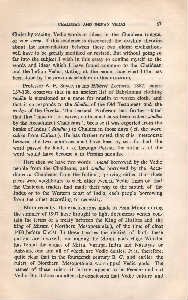Page 735 - Lokmanya Tilak Samagra (khand 2)
P. 735
CHALDEAN AND INDIAN VEDAS 87
Christ by tracing Vedic words or ideas in the Chaldean tongue,
or vice versa. If this evidence is discovered the existing theories
about the inter-relation between these two oldest civilizations
will have to be greatly modified or revised. But without going so
far into the subject I wish in this essay to confine myself to the
words and ideas which I have found common to the Chaldean
and the Indian Vedas, stating at the same time what little has
been done by the previous scholars in this direction.
Professor A. H. Sayee, in his Hibbert Lectures, 1887, page
137-138, observes that in an ancient list of Babylonian clothing
sindhu is mentioned as a name for muslin or woven cloth, and
that it corresponds to the Shadin of the Old Testament and the
cru'~" of the Greeks. The learned Professor has further stated
that this' muslin' or woven cloth must have been called sindhu
by the Accadians ( Chaldeans ), because it was exported from the
banks of Indus ( Sindhu ) to Chaldea in those days ( cf. the word
calico from Calicut ). He has further noted that this intercourse
between the two countries must have been by sea, for had the
word passed by land, i. e. through Persia, the initial s of the
word would have become h in Persian mouths.
Here then we have two words : mana borrowed by the Vedic
people from the Chaldeans, and sindhu borrowed by the Acca-
dians or Chaldeans from the Indians, proving either that these
races were neighbours to each other even in Vedic times or that
the Chaldean traders had made their way to the mouth of the
Indus or to the Western coast of India, each people borrowing
from the other according to necessity.
More recently, the exacavations made in Asia Minor during
the summer of 1907 have brought to light documents which con-
tain the terms of a treaty between the King of Hittites and the
king of Mitani (Northern Mesopotamia), of the time of circa
1400~before Christ. In these treaties the deities of both these
nations are invoked; and among the Mitani gods Hugo Winkler
has found the names of Mitra, Varu~a, Indra and Nasatyas or
Ashvins, one and all of which are Vedic deities. It is, therefore,
quite clear that in the fourteenth century B. C. and earlier the
rulers of Northern Mesopotamia worshipped Vedic gods. The
names of these rulers, it is true, appear to be Persian and not
Vedic. But it does not affect the conclusion that Vedic culture and

